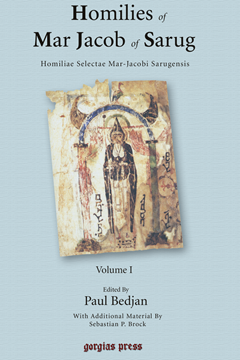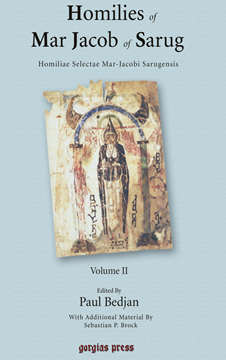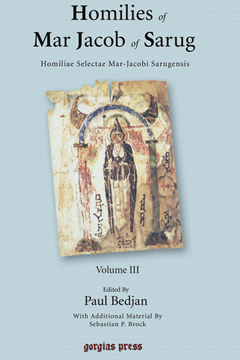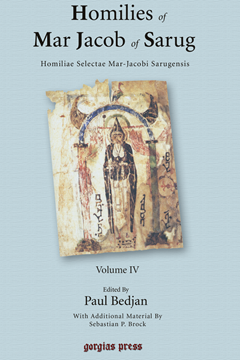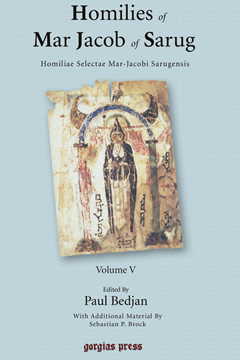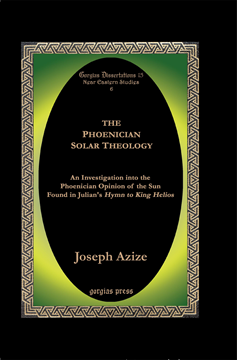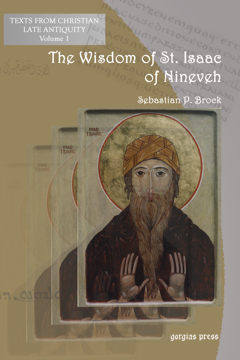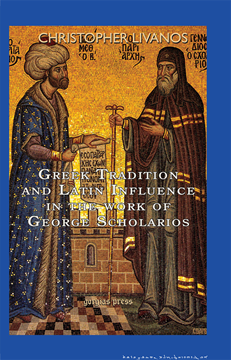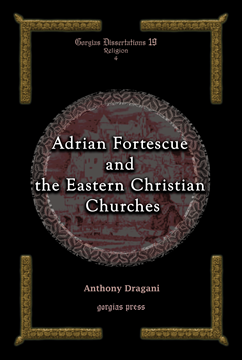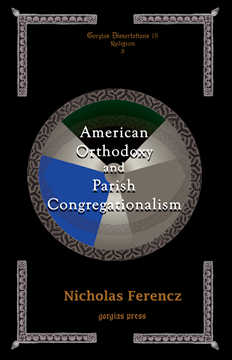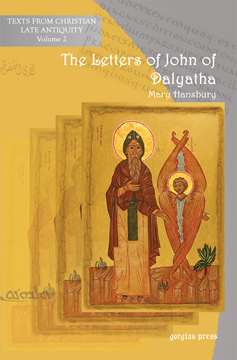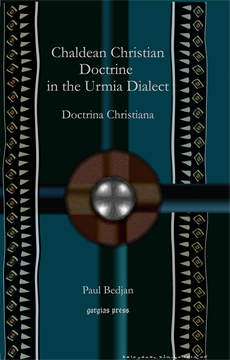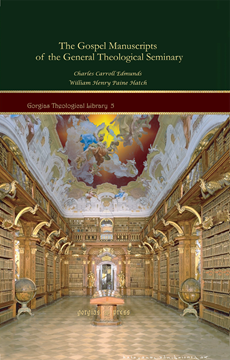Homilies of Mar Jacob of Sarug / Homiliae Selectae Mar-Jacobi Sarugensis (1 of 6 volumes)
Edited by Paul Bedjan and Sebastian P. Brock
ISBN: 1-59333-328-5
Jacob of Sarug is one of the most celebrated poets of Eastern Christianity and the Syriac tradition. The Gorgias Press edition, edited by Sebastian P. Brock, contains over 100,000 lines of poetry based on Bedjan’s 1905 edition.
$125.00 (USD)
Homilies of Mar Jacob of Sarug / Homiliae Selectae Mar-Jacobi Sarugensis (2 of 6 volumes)
Edited by Paul Bedjan and Sebastian P. Brock
ISBN: 1-59333-329-3
Jacob of Sarug is one of the most celebrated poets of Eastern Christianity and the Syriac tradition. The Gorgias Press edition, edited by Sebastian P. Brock, contains over 100,000 lines of poetry based on Bedjan’s 1905 edition.
$125.00 (USD)
Homilies of Mar Jacob of Sarug / Homiliae Selectae Mar-Jacobi Sarugensis (3 of 6 volumes)
Edited by Paul Bedjan and Sebastian P. Brock
ISBN: 1-59333-330-7
Jacob of Sarug is one of the most celebrated poets of Eastern Christianity and the Syriac tradition. The Gorgias Press edition, edited by Sebastian P. Brock, contains over 100,000 lines of poetry based on Bedjan’s 1905 edition.
$125.00 (USD)
Homilies of Mar Jacob of Sarug / Homiliae Selectae Mar-Jacobi Sarugensis (4 of 6 volumes)
Edited by Paul Bedjan and Sebastian P. Brock
ISBN: 1-59333-331-5
Jacob of Sarug is one of the most celebrated poets of Eastern Christianity and the Syriac tradition. The Gorgias Press edition, edited by Sebastian P. Brock, contains over 100,000 lines of poetry based on Bedjan’s 1905 edition.
$125.00 (USD)
Homilies of Mar Jacob of Sarug / Homiliae Selectae Mar-Jacobi Sarugensis (5 of 6 volumes)
Edited by Paul Bedjan and Sebastian P. Brock
ISBN: 1-59333-332-3
Jacob of Sarug is one of the most celebrated poets of Eastern Christianity and the Syriac tradition. The Gorgias Press edition, edited by Sebastian P. Brock, contains over 100,000 lines of poetry based on Bedjan’s 1905 edition.
$125.00 (USD)
Homilies of Mar Jacob of Sarug / Homiliae Selectae Mar-Jacobi Sarugensis (6 of 6 volumes)
Edited by Paul Bedjan and Sebastian P. Brock
ISBN: 1-59333-333-1
Jacob of Sarug is one of the most celebrated poets of Eastern Christianity and the Syriac tradition. The Gorgias Press edition, edited by Sebastian P. Brock, contains over 100,000 lines of poetry based on Bedjan’s 1905 edition.
$125.00 (USD)
The Phoenician Solar Theology (Hardcover)
An Investigation into the Phoenician Opinion of the Sun found in Julian's Hymn to King Helios
By Joseph Azize
Series: Gorgias Near Eastern Studies 15
ISBN: 1-59333-210-6
This book, the first study of its kind, contends that an authentic Phoenician solar theology existed, reaching back to at least the fifth or sixth century BCE. Through Azize’s examination, a portrait of a vibrant Phoenician tradition of spiritual thought emerges: a native tradition not dependent upon Hellenic thought, but related to other Semitic cultures of the ancient Near East, and, of course, to Egypt. In light of this analysis, it can be seen that Phoenician religion possessed a unique organizing power in which the sun, the sun god, life, death, and humanity, were linked in a profound system.
$169.00 (USD)
Authority within the Christian Church
By Peter Lee
ISBN: 1-59333-342-0
At the present time, when authority for the church's beliefs and actions is the subject of much discussion, this book attempts to look to the authority of God, Jesus Christ, and the Holy Spirit, and how these are transmitted within apostolic tradition by word, actions, and writings. Elements giving weight to authority (co-inherence, consistency, and universality) are examined along with the scope and limits of interpretative tradition.
$142.00 (USD)
The Wisdom of Isaac of Nineveh
A Bilingual Edition
Series: Texts from Christian Late Antiquity 1
ISBN: 1-59333-335-8
From one of the most thought-provoking writers in the monastic tradition, this volume contains 153 short, contemplative sayings of St. Isaac of Nineveh (fl. 661-681 CE) in their original Syriac with facing English translation. St. Isaac was ordained bishop of Nineveh but resigned his post only five months later and became a monastic hermit in the mountains of southeastern Iraq. This work speaks to believing Christians today as well as scholars wishing to learn more about the Eastern monastic tradition.
$32.00 (USD)
Bellah, Habermas and Giddens
By Hanan Reiner
Series: Gorgias Studies in Religion 21
ISBN: 1-59333-225-4
Scholars from various fields of study have long dealt with the relationship between religion and science. This subject has found a particular expression in sociology. Sociologists and other scholars agree that even though religion and science can be seen as separate from each other, there are several commonalities between the two. The common ground between Bellah, Giddens, and Habermas – the meaningful position the Subject has/should have in constructing the social reality – brings to light a transition in the sociological theoretical arena, if we take into account the different theoretical roots of each scholar – Functionalism (Bellah), Positivism (Giddens), and Neo-Kantian (Habermas).
$111.00 (USD)
Greek Tradition and Latin Influence in the Work of George Scholarios
“Alone Against All of Europe”
ISBN: 1-59333-344-7
This title is a study of the work and career of theologian and diplomat George Scholarios who became the first Ecumenical Patriarch of the Orthodox Church during the period of Ottoman Rule. Scholarios advocated the union of the Greek and Latin Churches, but he later became the leader of the anti-Unionist faction in the final years of the Byzantine Empire. Scholarios played an important role in East-West dialogues, including the Council of Ferrara-Florence in 1438-39. This book provides a fresh look at some of the cultural misunderstandings that took place at the Council and related dialogues.
$125.00 (USD)
Adrian Fortescue and the Eastern Christian Churches
Series: Gorgias Studies in Religion 19
ISBN: 1-59333-345-5
Adrian Fortescue (1874-1923) was recognized as one of England’s foremost authorities on Eastern Christianity and helped to shape the English-speaking world’s understanding of the Eastern Churches. This book is a critical examination of his writings on the subject, analyzing what he said about the Eastern Christian Churches and highlighting his insights into key questions. It focuses on Fortescue’s understanding of the schisms and his thoughts as to how reunion can come about. The book concludes by comparing Fortescue's perspective to later advances in theology and historical scholarship in order to ascertain the long-term accuracy of his writings.
$145.00 (USD)
American Orthodoxy and Parish Congregationalism
Series: Gorgias Studies in Religion 18
ISBN: 1-59333-195-9
Orthodox ecclesiology doctrinally and historically requires that all authority in the church be expressed by the bishop. The unity of authority, based upon the laying on of hands, is the lived expression of the oneness and catholicity of the church. American Orthodoxy, however, does not have such an authority structure, especially on the parish level. This study explores the divergence of practice from doctrine in the American church. The study concludes with a theological discussion of the problematic nature of parish congregationalism in Orthodoxy. It points toward the already-realized conciliarity of supra-parish structures as the paradigm for a reformation of parish authority structures.
$146.00 (USD)
The Letters of John of Dalyatha
Series: Texts from Christian Late Antiquity 2
ISBN: 1-59333-341-2
John of Dalyatha (690-780 CE) was a monk from a monastery near the Turkey-Iraq border. After living in the monastery for only seven years, he received permission to live a solitary life in the over 9,000 ft high mountains of Dalyatha where he spent most of his life. When he became too old to live on his own, he came down from the mountains, formed a community around himself and wrote these works. In them, John outlines the life itinerary of those who are baptized, the "Way of Wonder" - leading to the vision of God.
$80.00 (USD)
Jesus the Galilean
Soundings in a First Century Life
ISBN: 978-1-59333-313-3
Who was Jesus, really? That question has been debated by academics for the last two centuries, and contributions to this important issue in the history of Christianity are still making an impact on public opinion. Jesus the Galilean takes soundings in the life of the historical Jesus based on four readings from the Gospel of Mark which represent some of the most controversial issues in the current scholarly discussion about the historical Jesus. This book explores what can be known about the historical Jesus in the historic Galilee.
$156.00 (USD)
Theodora
With Translation and Introduction by Matti Moosa
ISBN: 1-59333-314-5
Western sources have long referred to Theodora as an infamous and salacious courtesan who became Justinian’s empress. Syriac sources portray her as a woman of sublime character and decorum, the daughter of a Syriac priest. This historical play outlines her character according to the Syriac tradition. In writing the play, Bishop Gregorius Boulos Behnam portrayed Theodora as a virtuous lady who won the heart of Justinian, who made her his Augusta and co-regent of his empire. Behnam reveals her extraordinary devotion to her faith and piety as she strives to protect the Fathers of the Syriac Church who stood against the declarations of the Council of Chalcedon and were persecuted for it. Now available for the first time in English, this edition translated by Matti Moosa stands counter to the view of Theodora as portrayed by Procopius in his version of the story, as it is popularly known in Western Christendom.
$58.00 (USD)
A Study in Black Holiness-Pentecostalism
Series: Gorgias Studies in Religion 23
ISBN: 1-59333-317-x
This project was inspired by years of nurture and ministry in the church upon which the study focuses. With roots going back to the historic African American Church, it offers a window into early growth, the development of crucial theological positions, institutional development within the American Church of the twentieth century, and emerging patterns for worldwide Christianity in the twenty-first century. The struggle within this project is against a background of misunderstanding. Given the pejorative biases in earlier studies against African American Christianity in general, and Holiness-Pentecostalism in particular, a contest is under way for placement within the appropriate taxonomy.
$132.00 (USD)
A Biblical Perspective
Series: Gorgias Eastern Christian Studies 2
ISBN: 978-1-59333-324-9
A popularly-written study of the biblical roots of the Eastern Orthodox Church’s mystical understanding of the knowledge of God. This unique study brings together the best of contemporary exegesis with the tradition of Eastern Christianity and illustrates the biblical roots of the Eastern Church's understanding of grace as the energy of God. The book presents, in lay terms, the shape for an Orthodox biblical theology for the 21st century and will be of interest to all Christians for whom the Bible is divine revelation and for whom tradition continues to be creative.
$173.00 (USD)
Nestorian Questions on the Administration of the Eucharist by Isho'yabh IV
A Contribution to the History of the Eucharist in the Eastern Church
ISBN: 1-59333-409-5
Willem Cornelis van Unnik gives a comprehensive research of the liturgical writings of Isho’yabh IV in the context of the "Nestorian" liturgical tradition based on the manuscript tradition. After an analysis of the text, the author gives an annotated English translation of the text and a reproduction of the original Syriac text with a critical apparatus.
$181.00 (USD)
The Making and Unmaking of a Jesuit
ISBN: 978-1-59333-450-5
The Jesuits—that group of clerics so deeply imbedded in the dreams and nightmares of the Catholic Church and in the history of the world. Sometimes saints and sometimes energetic and devious schemers, the Jesuits have educated and trained most of the Catholic intellectuals of America and Europe for the last four hundred years. F. E. Peters throws open the doors of the Jesuit citadel in this story of a young man’s coming of age. This is a personal story told without romance and without rancor, and if the Jesuit life is one of bondage to an almost impossible ideal of perfect obedience and self-denial, it is also, as Ours makes clear without the slightest trace of jesuitical equivocation, a life of intelligence, of intense camaraderie, and of high good humor.
$89.00 (USD)
Chaldean Christian Doctrine in the Urmia Dialect
Doctrina Christiana
By Paul Bedjan
ISBN: 978-1-59333-420-8
Paul Bedjan produced this catechism to advance the knowledge of Catholicism among Aramaic-speaking Christians of the Middle East. The book is written in Modern Aramaic, in the dialect of Urmia. The book is of interest not only for pedagogical purposes among the Aramaic speakers, but also will give the Neo-Aramaic scholar a literary text from the late nineteenth century.
$123.00 (USD)
The Book of Ethics
Edited by Paul Bedjan
ISBN: 978-1-59333-421-5
Bar Hebraeus, a celebrated Syriac writer of the thirteenth century, wrote on nearly every subject imaginable. The Book of Ethics is a manual of discipline and etiquette covering secular life as well as spiritual life.
$241.00 (USD)
The Beginnings of the Theological Seminary of the Reformed Church in the United States
From 1817-1832
Series: Kiraz Theological Archive 9
ISBN: 1-59333-460-5
In this painfully honest study, Appel describes the trials behind the early stages and the eventual success of the Theological Seminary of the Reformed Church in the United States. The first theological school of the German Reformed Church in America, the Theological Seminary opened in 1825. Appel analyzes the circumstances from 1817-1832.
$115.00 (USD)
Christianity and History
Series: Kiraz Theological Archive 8
ISBN: 1-59333-461-3
Harnack’s classic lecture on the relationship between history and Christianity has stood the test of time. Both the concepts of personality and history are closely examined. Harnack asserts that historical criticism causes no real damage to authentic Christianity.
$101.00 (USD)
The Gospel Manuscripts of the General Theological Seminary
Series: Kiraz Theological Archive 5
ISBN: 1-59333-463-X
Three miniscule gospel codices held by the General Theological Seminary in New York are published in partial facsimile form, along with thorough collations and descriptions. Codices Gregory 669, 2324, and 2346 are included.
$108.00 (USD)
